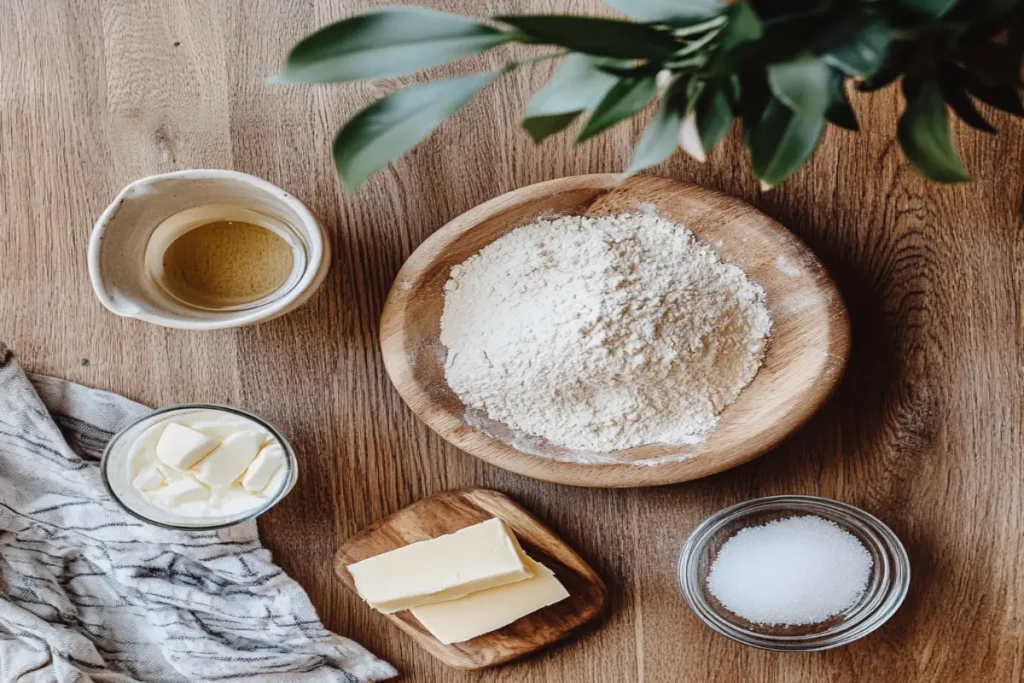Introduction
Sourdough sandwich bread offers a delightful variation on the traditional sourdough loaf, combining the tangy flavor of fermented bread with a soft, sliceable texture that’s ideal for sandwiches. Whether you are a home baker or a passionate bread enthusiast, mastering this bread can significantly enhance your culinary skills. In this guide, we explore everything you need to know, including an introduction to sourdough sandwich bread and solutions to common baking challenges. Additionally, don’t miss our tips for maintaining a healthy starter and perfecting your baking techniques.
Table of contents
What is Sourdough Sandwich Bread?
Sourdough sandwich bread is a softer, more versatile variation of traditional sourdough bread. Unlike rustic sourdough, with its chewy crust and open crumb, this bread is specifically crafted for sandwiches. As a result, it offers several key advantages:
- A soft crust: Ideal for easy slicing and eating.
- A tight, even crumb: Holds fillings without breaking apart.
- A milder tang: A flavor that complements both savory and sweet spreads.
Key Features
- Natural fermentation: Made with a sourdough starter, using wild yeast for leavening.
- No commercial yeast: Offers a more traditional, wholesome baking method.
- Longer shelf life: The acidity from fermentation acts as a natural preservative.
- For a deeper dive into the health benefits of sourdough bread, check out this article from Healthline.
Sourdough sandwich bread is not just a functional bread; it’s a flavorful, nutrient-packed base for your favorite meals. If you’re looking for more bread recipes, browse our selection of tasty, easy-to-make loaves.
Why Choose Sourdough for Sandwich Bread
There are countless reasons why sourdough sandwich bread stands out as a healthier and tastier option compared to conventional bread. Here’s why it should be your top choice:
1. Health Benefits
- Improved digestibility: Natural fermentation partially breaks down gluten, making it easier on the stomach.
- A low glycemic index: This means it helps regulate blood sugar levels more effectively compared to regular bread, making it a healthier option for those looking to manage glucose levels.
- Rich in nutrients: Contains more iron, magnesium, and antioxidants.
- Read more about sourdough’s nutritional benefits.
2. Unique Flavor and Texture
- Balanced tanginess: The fermentation process imparts a subtle sourness that enhances the bread’s flavor profile.
- Soft yet sturdy texture: Perfect for sandwiches, from simple peanut butter to gourmet deli fillings.
3. Longevity and Freshness
Thanks to its natural acidity, sourdough sandwich bread remains fresh for longer periods without the need for artificial preservatives.
In essence, sourdough sandwich bread offers a healthier, more flavorful, and sustainable option for daily use. For an added treat, pair your sourdough creations with tea-time delights like Earl Grey Cookies to enjoy a well-rounded and satisfying snack experience.
How to Make Sourdough Sandwich Bread at Home
Baking sourdough sandwich bread at home might seem intimidating, but with the right process, it becomes straightforward and rewarding. Here’s a detailed breakdown:
1. Essential Ingredients

- Flour: Bread flour works best for structure, while whole wheat or rye adds flavor and nutrition.
- Water: Use filtered water to avoid any interference with fermentation.
- Salt: Enhances flavor and strengthens the dough.
- Sourdough starter: An active, bubbly starter is key for leavening.
2. Step-by-Step Process
a. Preparing Your Starter
First, feed your starter 8-12 hours before baking to ensure it’s active. Look for bubbles and a slightly tangy aroma, which indicate that it is ready to use.
b. Mixing the Dough
Next, combine your starter, flour, water, and salt. Stir thoroughly until all the ingredients are well incorporated. Then, let the mixture rest for 30 minutes to promote gluten development.
c. Stretching and Folding
Instead of traditional kneading, perform a series of stretches and folds every 30 minutes. This technique helps build the dough’s strength while preventing overworking.
d. Proofing
Afterward, allow the dough to rise in a warm place until it doubles in size. Keep in mind that this step can take 4-6 hours, depending on room temperature.
e. Shaping
Once risen, shape the dough into a loaf and place it into a greased loaf pan. Then, cover it and let it proof again until it rises slightly above the edge of the pan.
f. Baking
Finally, preheat your oven to 375°F (190°C). Bake the loaf for 35-40 minutes until the crust turns golden brown and the bread sounds hollow when tapped. Let it cool before slicing and serving!
3. Tips for Success
- Maintain a consistent room temperature for proofing.
- Use a scale for precise measurements.
- Practice patience; fermentation takes time for the best flavor and texture.
By following these steps, you’ll be able to create a loaf of perfect sourdough sandwich bread at home. Want to try other bread-making techniques? Check out our bread baking basics for more insights.
Troubleshooting Common Issues
Even experienced bakers encounter challenges when making sourdough sandwich bread. Below are common problems and their solutions:
- Dough Not Rising
- Cause: Weak starter or a cold proofing environment.
- Solution: Ensure your starter is active and vibrant. Additionally, proof the dough in a warmer area (around 75-78°F).
- Overly Dense Bread
- Cause: Insufficient proofing or underdeveloped gluten.
- Solution: Allow the dough more time to rise, and use stretch-and-fold techniques to strengthen the gluten.
- Crust Too Hard
- Cause: High baking temperature or a lack of steam during baking.
- Solution: Lower the baking temperature and place a pan of water in the oven to create steam.
- Overproofing
- Cause: Leaving the dough out too long during the final rise.
- Solution: Monitor the dough carefully and perform the “poke test.” If the dough springs back slowly, it’s ready to bake.
- Uneven Texture
- Cause: Improper mixing or shaping techniques.
- Solution: Mix the dough thoroughly to ensure even incorporation, and shape it tightly to avoid air gaps.
- Bread Tastes Too Sour
- Cause: Overfermentation or an overly acidic starter.
- Solution: Reduce fermentation times and feed your starter more frequently to balance its acidity.
By addressing these issues, you’ll improve your baking skills and consistently produce high-quality sourdough sandwich bread. For more troubleshooting tips, be sure to check out our bread troubleshooting guide.
The Comprehensive Guide to Sourdough Sandwich Bread.
Sourdough Sandwich Bread Recipes
Homemade sourdough sandwich bread recipes provide endless opportunities for variety and personalization in your baking. Here are some top recipes to try:
- Classic Sourdough Sandwich Bread
- Ingredients: Bread flour, water, salt, and sourdough starter.
- Process: Mix the ingredients, knead the dough, and allow it to ferment. Shape it into a loaf and bake at 375°F until the crust turns golden brown.
- Results: This bread features a mild tang, a soft crumb, and a smooth crust, making it perfect for everyday sandwiches.
- Whole Wheat Sourdough Sandwich Bread
- Ingredients: A blend of whole wheat flour and bread flour.
- Health Benefits: This recipe adds fiber, nutrients, and a nutty flavor to your bread.
- Best Uses: It pairs wonderfully with spreads like peanut butter, honey, or avocado.
- Gluten-Free Sourdough Sandwich Bread
- Ingredients: Rice flour, tapioca starch, and gluten-free sourdough starter.
- Features: This recipe is a fantastic option for those with dietary restrictions, offering the classic sourdough tang without gluten.
Experiment with these recipes to enjoy fresh, nutritious sourdough sandwich bread at home. For more gluten-free recipes, explore our collection of gluten-free breads.
Using Sourdough Sandwich Bread in Everyday Meals

Sourdough sandwich bread is versatile, lending itself to a range of delicious meals:
1. Perfect for Sandwiches
- Use it for classic ham and cheese, veggie-loaded sandwiches, or gourmet grilled cheese.
- The soft texture complements spreads and fillings without breaking.
2. Breakfast Delights
- Ideal for French toast: Dip in egg batter and fry for a crisp yet tender result.
- Toast with butter and jam offers a quick, flavorful start to the day.
3. Beyond Sandwiches
- Croutons: Cube stale bread and toast for soups and salads.
- Bread Pudding: Combine with milk, sugar, and eggs for a comforting dessert.
- Garlic Bread: Spread with butter and garlic, then bake.
By incorporating sourdough sandwich bread into your meals, you can elevate everyday dishes with ease. To get more creative with your bread, check out our bread-based recipes.
Caring for Your Sourdough Starter
A healthy sourdough starter is the foundation for successful sourdough sandwich bread. Proper care ensures consistent results:
1. Feeding Your Starter
- Feed it daily if stored at room temperature or weekly if refrigerated.
- Use equal parts water and flour to maintain the right consistency.
2. Storing Your Starter
- For frequent use: Keep it at room temperature and feed regularly.
- For infrequent use: Refrigerate in an airtight container, and revive before baking.
3. Troubleshooting Common Starter Issues
- Inactive Starter: Feed it more frequently and ensure a warm environment (75°F).
- Overly Sour Starter: Refresh by discarding some and feeding with fresh flour and water.
Consistency is key when caring for your starter. With proper maintenance, it will last for years, producing flavorful sourdough sandwich bread every time.
FAQs About Sourdough Sandwich Bread
The Difference Between Sourdough and Sandwich Sourdough
Sourdough bread and sourdough sandwich bread have distinct characteristics. Traditional sourdough is known for its crusty exterior and open, airy crumb, making it ideal for artisan-style loaves. In contrast, sourdough sandwich bread is crafted with a softer crust and denser, more uniform crumb, making it easier to slice and perfect for holding sandwich fillings. While sandwich sourdough offers a milder flavor to appeal to a broader audience, both varieties retain the distinctive tang of fermented dough.
Health Benefits of Sourdough Bread
Sourdough bread is generally easier on the stomach than regular bread due to its natural fermentation process. This fermentation partially breaks down gluten and starches, enhancing digestibility. It also introduces probiotics and prebiotics, which support gut health. Additionally, the extended fermentation reduces phytic acid, allowing better absorption of minerals like magnesium and iron, thus contributing to overall digestive well-being.
Tips to Speed Up Sourdough Preparation
For those looking to accelerate the sourdough bread-making process, several strategies can help:
- Warm Proofing Environment: Ferment the dough in a warm spot (75–78°F) to enhance activity.
- Increased Starter Quantity: Adding more active starter to the dough can speed up rising.
- Use Warm Water: Mix the dough with warm water to activate the starter quickly.
- Shortened Bulk Fermentation: Monitor closely and reduce fermentation time without compromising structure.
These methods must be applied carefully to preserve the signature flavors and textures of sourdough.
What Makes Sourdough Unique? The natural fermentation process with a starter sets sourdough apart from breads made with commercial yeast.
How Long Does Sourdough Stay Fresh? Sourdough sandwich bread stays fresh for 3–5 days when stored in an airtight container at room temperature.
Can Sourdough Be Frozen? Yes, sliced sourdough can be wrapped in foil or plastic and frozen for up to three months.
Why Is My Sourdough Dense? A dense texture often results from underproofing or insufficient gluten development during mixing.Here are ans
These FAQs address key concerns to help you bake and enjoy sourdough sandwich bread with confidence.
Conclusion
In conclusion, it is evident that sourdough sandwich bread is not only a delightful choice but also a valuable skill to add to your baking repertoire. Its distinctive flavor, tender texture, and numerous health benefits make it a versatile and indispensable staple in any kitchen. By perfecting recipes, creatively incorporating it into meals, and diligently maintaining your starter, you can fully embrace the endless possibilities this timeless bread offers. So, take the leap, start experimenting today, and savor the delicious rewards of your hard work and dedication.

